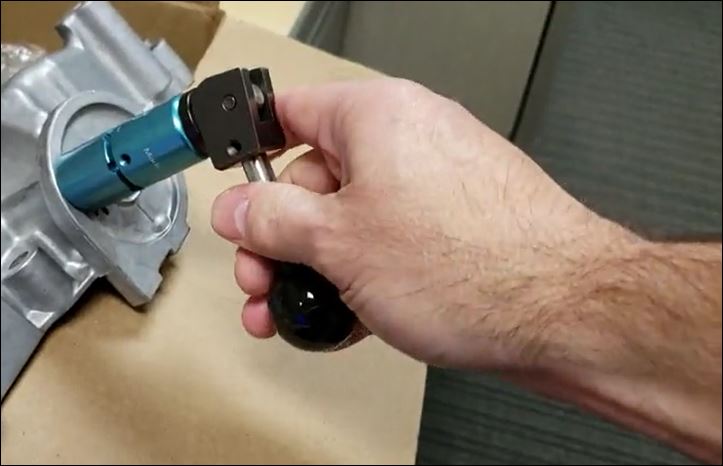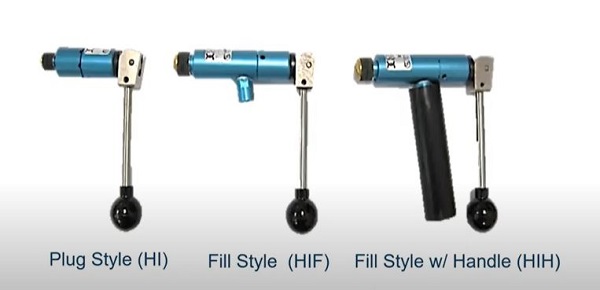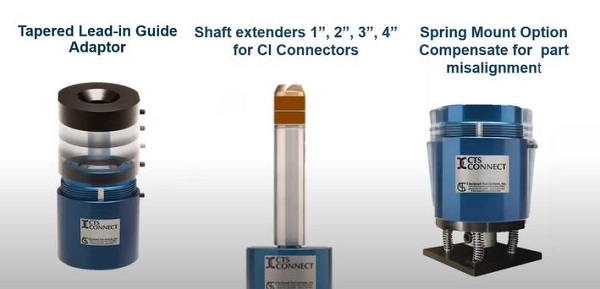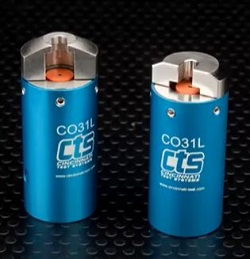9 considerations to find the right CTS Connect® leak test connectors and seals
Finding the proper seal or connector for your leak test can feel daunting. There are many variables to consider to ensure a tight, reliable fit during test. Cincinnati Test Systems makes this easy with our
CTS Connect® line of connectors, seals, and fittings, each designed to meet the challenges of your leak test scenarios.
Below is a list of considerations we use to help us identify your specific needs and match you up with the right instrumentation to ensure an accurate test, every time.
Another great feature of the CTS Connect line is our threaded and tapered nose design with wrench flats, which makes it quick and simple to replace the seal.
CTS’ ID seals feature our patented built-in ‘stroke limiter’. With the stroke limiter feature, when this seal is actuated outside of a port, it doesn’t pop the seal off. It will stop before you over-compress the seal, which would require potential down-time to reinstall the seal back onto the connector.
CTS’ OD seals consists of an air-driven internal piston that compresses seal material against the surface of the part, creating a tight seal that meets all test pressure requirements.
Pneumatic, air-actuated connectors are often the preferred choice for automated test systems.
We also offer a variety of manually actuated seals for your manual stations, each with a cam-actuated levered design. You manually place the seal into a part (ID seals) and actuate the cam lever handle to quickly and effectively seal your test part. We have options from ¼” to 3”, and up to 100psi to suit your test needs.
If you have very smooth bores, we recommend adding lanyard to this setup. That way, if there is an event where it pops out, it can catch the seal before it moves too far.
It will also dictate potential accessories that may be helpful—like, for example, a lanyard if manually connecting, particularly when testing at high pressures, when it is more likely that a connector may pop off during test.
One example is the tapered lead-in guide adapter for OD style seals. This tapered, funnel-shaped lead-in feature helps with compensating for minor test part misalignment, by guiding the device/part into the CTS Connect more easily.
Another example is our spring mount adapter which offers a lead-in and some compliance as interface with your test part, in which is assists with compensating for some minor misalignment issues.


For applications that require sealing and testing male or female luer lock fittings, we offer the CO31L—a specially designed specifically for sealing luer lock fittings for medical applications. It is an air-actuated, face sealing style connector, designed to seal male and female luer lock fittings, while the test fitting is held positively in place by a custom-designed nose piece. Our CO31L also utilizes our patent-pending and easy “quick-change nose” design, in which the nose piece quickly and securely locks into place to accommodate multiple luer fitting designs.
We also offer a specialized solution for sealing and testing flexible medical tubing. This device is an OD seal that fits over a stainless steal pin, which helps support your tubing as you actuate the seal ad compress on the outside diameter of your tubing.
Below is a list of considerations we use to help us identify your specific needs and match you up with the right instrumentation to ensure an accurate test, every time.
1.Do you need an ID (inner diameter) seal, or OD (outer diameter) seal for your test port?
Whether you need to seal your part or components on the inside or outside diameter will be the first consideration to identify the right seal for your needs. CTS’ uniquely designed inner diameter and outer diameter seals are equipped with unique features, designed to solve the issues manufacturers face when sealing. CTS Connect ID and OD seals effectively seal on smooth and threaded circular features of a part for either pressure or vacuum testing, filling or flushing.Another great feature of the CTS Connect line is our threaded and tapered nose design with wrench flats, which makes it quick and simple to replace the seal.
CTS’ ID seals feature our patented built-in ‘stroke limiter’. With the stroke limiter feature, when this seal is actuated outside of a port, it doesn’t pop the seal off. It will stop before you over-compress the seal, which would require potential down-time to reinstall the seal back onto the connector.
CTS’ OD seals consists of an air-driven internal piston that compresses seal material against the surface of the part, creating a tight seal that meets all test pressure requirements.

2.Do you need a manually-actuated hand seal, or a pneumatic, air-actuated connector?
Will the connector be located on your test part manually by an operator, or will it be used as part of an automated test system? The answer to this question will help you determine whether you want a manual or pneumatic connector.Pneumatic, air-actuated connectors are often the preferred choice for automated test systems.
We also offer a variety of manually actuated seals for your manual stations, each with a cam-actuated levered design. You manually place the seal into a part (ID seals) and actuate the cam lever handle to quickly and effectively seal your test part. We have options from ¼” to 3”, and up to 100psi to suit your test needs.
If you have very smooth bores, we recommend adding lanyard to this setup. That way, if there is an event where it pops out, it can catch the seal before it moves too far.
3.If choosing a manually-actuated connector, do you need the plug on its own, or with fill port, or with fill port and handle option?
For our manually-actuated hand seals, there are three options to choose from:- A plug only style, which does not include a test/fill inlet port to supply test pressure to the test part.
- A fill style, which includes a test/fill inlet port to allow you to supply test pressure to the test part.
- A fill style with handle, which includes a test/fill inlet port to allow you to supply test pressure to the test part, and also comes with cushioned, rubber gripped handle option.

4.What is the test pressure that the CTS Connect will be sealing?
The highest and lowest pressure required during your test will dictate the model of connect or seal you’ll need.It will also dictate potential accessories that may be helpful—like, for example, a lanyard if manually connecting, particularly when testing at high pressures, when it is more likely that a connector may pop off during test.
5.Are you sealing a smooth diameter, or do you have a threaded port?
CTS offers a variety of options whether you are testing smooth diameter ports or a threaded port. Whether you are sealing a smooth or threaded diameter will dictate the right Connect model—and also associated seal kits to ensure an effective test.6.What is the size/diameter of your test port?
The size and diameter of your test port are clearly an important metric to consider in identifying an adequate seal for your needs—however it is not always completely clear. Factors like interference or design of a part can affect how a connect or seal will be applied. To ensure the proper size and fixturing set up for your test, we suggest sending the drawings of your 3D models to ensure you have the best fit.7.Would your test scenario benefit from spring mount adapters or tapered lead-in guide adapters?
We offer a variety of accessories that make these connects and seals easy to implement into your tooling. These adapters are helpful as they can improve the performance and consistency of your automated test system by compensating for a misalignment or inconsistency in seal placement.One example is the tapered lead-in guide adapter for OD style seals. This tapered, funnel-shaped lead-in feature helps with compensating for minor test part misalignment, by guiding the device/part into the CTS Connect more easily.
Another example is our spring mount adapter which offers a lead-in and some compliance as interface with your test part, in which is assists with compensating for some minor misalignment issues.

8.If you’re using a pneumatic, air-actuated connector, do you need a stem extension?
Stem extenders, or shaft extenders, are helpful if you have interferences around your parts or hard-to-reach testing locations within a part or assembly. These extenders allow you to reach the hard to reach fittings around or inside of a part design when you have clearance issues during test. We offer these standard in 1”, 2”, 3”, or 4”—as well as custom options.9.Is this a medical sealing application?
CTS supplies a full range of CTS connectors and seals designed to meet the special requirements of the medical device industry:- All components that contact test part will be a medical grade stainless steel
- Medical grade seal materials

For applications that require sealing and testing male or female luer lock fittings, we offer the CO31L—a specially designed specifically for sealing luer lock fittings for medical applications. It is an air-actuated, face sealing style connector, designed to seal male and female luer lock fittings, while the test fitting is held positively in place by a custom-designed nose piece. Our CO31L also utilizes our patent-pending and easy “quick-change nose” design, in which the nose piece quickly and securely locks into place to accommodate multiple luer fitting designs.
We also offer a specialized solution for sealing and testing flexible medical tubing. This device is an OD seal that fits over a stainless steal pin, which helps support your tubing as you actuate the seal ad compress on the outside diameter of your tubing.
Are you looking for reliable standard or custom pneumatic leak test connectors or seals, manual leak test connectors, connectors for medical device leak testing, or support with custom fixturing at your stations? Learn more about the CTS Connect® line in this on-demand presentation, or contact us to discuss!

